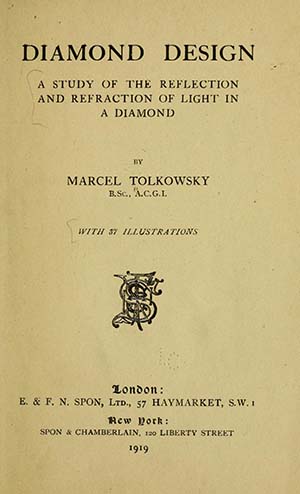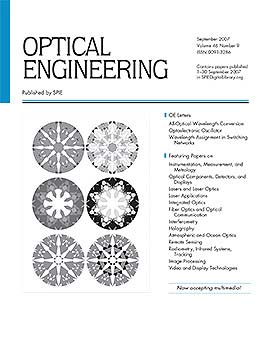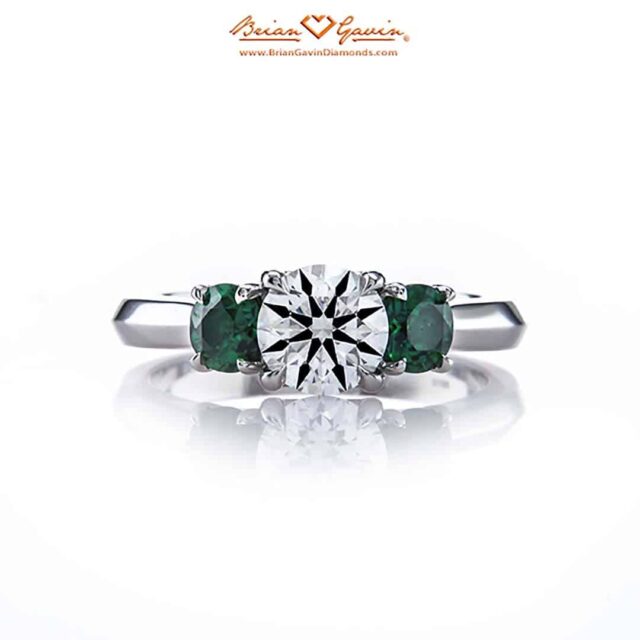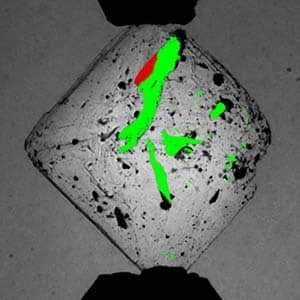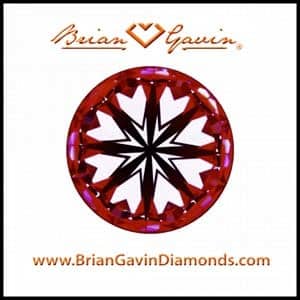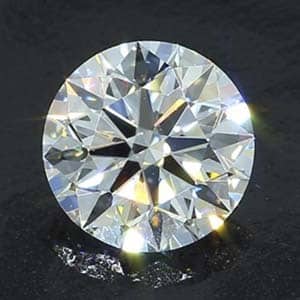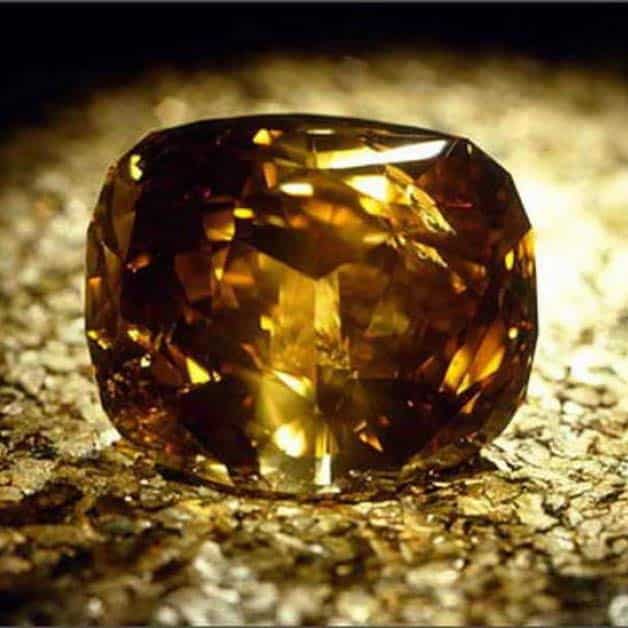The Tolkowsky ideal cut diamond design relies on specific proportions to maximize light return and produce a balance of brilliance and dispersion in rounds.
Even though Marcel Tolkowsky was only 21 years old when he published Diamond Design, many people recognize him as the creator of the ideal cut diamond.
The proportions diagram on the left reveals the formula for the original Tolkowsky Ideal Cut Diamond. Inasmuch as his design was based on modern theories of light behavior, we've come a long way since then.
For instance, the cutting process for the Black by Brian Gavin Diamonds is so unique that its patented. With that in mind, I'm sure you'll want to read my review of the Black Collection.
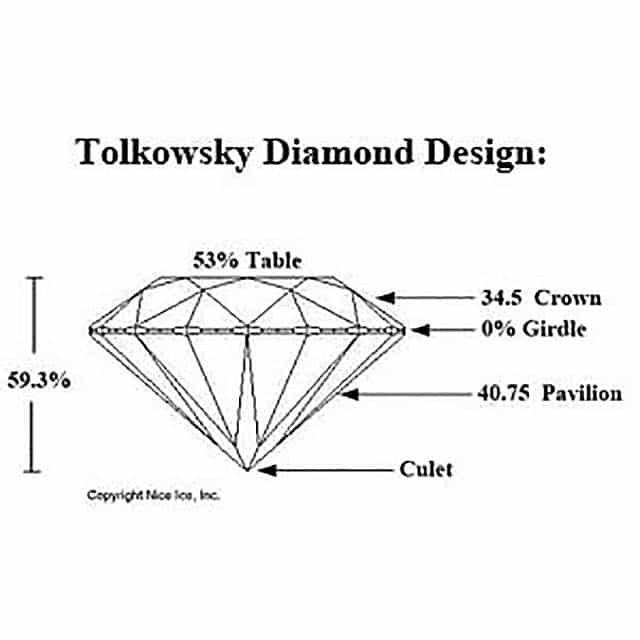
Tolkowsky Diamond Proportions.
Marcel is most notably known as a mathematician, but he was also a physicist and an engineer. By and large, the majority of research for improving light performance of diamonds is built upon his work.
Consequently, the Tolkowsky family moved from Bialystok, Poland to Antwerp, Belgium around 1840. Which makes perfect sense seeing that Antwerp, Belgium is the central hub for diamond cutting.
Tolkowsky Diamond Proportions:
According to Marcel's calculations, a round brilliant cut diamond should be cut to the following proportions:
Under those circumstances, the total depth of a Tolkowsky diamond should be split up like this:
Effect of 16% Crown Height on RBCD:
Be that as it may, we now know that a 16% crown height is too steep by modern standards. In the first place, the steeper crown height tends to make diamonds look amazing under jewelry store halogen lighting.
By the same token, it's likely to make round diamonds look dark in the middle under other light sources. Although this may be true, the reason for the discrepancy is the light source and not the crown height.
Comparatively speaking, jewelry store halogen lighting is a pin-fire light source. As such, it is designed to re-create the effect of illumination by fire or candlelight. Perhaps, this is the reason why most Tiffany & Co., jewelry showrooms seem dark to me.
Of course, the majority of us do not live and work under the illumination of candlelight. Since that source of lighting went out with the dark ages. At the present time, the majority of people live and work under diffused and florescent lighting.
For that reason, round diamonds with a 16% crown height are not a good option in the modern age. Suffice to say, but a lot has changed since Tolkowsky's time.
First, we live and work under completely different lighting environment. Secondly, there have been major advancements in diamond cutting and planning technology. With that said, there is still a lot we can learn from his research. So, keep reading Padawan.
The Tolkowsky Diamond Formula:
In light of the formula above, you might believe that you possess the magic keys to the kingdom. Although this may be true, things are rarely as simple as they first appear.
To begin with, Tolkowsky's design has the potential to produce higher volumes of light return. However, it's important to realize that there may be some issues with his mathematical model of the world.
With that in mind, you should read the rest of the story before running off like Jack the Giant Slayer. Firstly, Marcel Tolkowsky acknowledges the importance of the girdle edge throughout his book Diamond Design.
Secondly, none of his diagrams clearly define a measurable girdle edge which means his calculations are incomplete. In light of this apparent omission, many historians believe that Tolkowsky's calculations account for a knife edge girdle.
Meanwhile, it's not advisable, nor feasible to produce modern round brilliant cut diamonds with such a thin girdle edge. For one thing, there must be a measurable separation between the crown and pavilion sections of the diamond.
Otherwise it would be impossible to polish the facets and shape them properly along the girdle edge. Another key point to remember is that a thin girdle edge is prone to damage. In other words, it's advisable for the girdle edge of a diamond to be 0.7% or more for durability reasons.
Under those circumstances, it's fair to say that there are some issues with the Tolkowsky Diamond Design. Although that may be true, it is laid the groundwork for significant advancements in light performance.
Did Tolkowsky Forget the Girdle Edge?
At the same time Tolkowsky appears to overlook the girdle edge in his diamond design, we know that he didn't. For one thing, his work states: "Where the cut is somewhat less fine and the girdle is left somewhat thick (to save weight), that facet is sometimes made 3° steeper, or even more, than the pavilion.”
Be that as it may, I don't want you to spend too much time pondering the technical implications of that sentence. On the condition that I'm taking it out of the middle of a paragraph without providing the full context. By the same token, my intention is to simply acknowledge his awareness that the girdle edge exists.
Birth of the American Ideal Cut Diamond:
Granted that Tolkowsky is most notably recognized for his equations that gave birth to the modern round ideal cut diamond. Consequently, his calculations also became the framework for the American Ideal Cut Diamond.
By the way, the reason it's called the American Ideal Cut Diamond is because it originated in New York City. Although this may be true, it's reasonable to assume that Marcel's work was the inspiration.
After all, the Father of the American Ideal Cut Diamond is none other than Lazare Kaplan. Since you're probably not up on the family gossip, I'll let you know that Lazare and Marcel were cousins.
Lazare Kaplan International (LKI) was established in New York City in the early 1900s. Meanwhile, Marcel Tolkowsky published his work Diamond Design in 1919.
Under those circumstances, you might wonder which came first? The chicken or the egg? The Tolkowsky or American Ideal Cut Diamond?
Or perhaps it's all a matter of coincidence? I think not because the odds are that the members of this well-known diamond cutting family were kibitzing.
The AGSL Weighs In on Diamond Design:
"From Tolkowsky’s time the round brilliant cut has been improved by increasing the girdle thickness, including girdle facets, reducing the culet size, and increasing the length of the lower girdle facets and star facets."
The statement above regarding Tolkowsky's Diamond Design was made by AGS Laboratory researchers. You can find it in the article "Evaluation of brilliance, fire, and scintillation in round brilliant gemstones."
The article appears inside the September 2007 edition of Optical Engineering. If you're looking for a little "Light Reading" that article explains AGS ASET in 25 pages.
Of course, this is beyond the scope of interest for most people. On the condition that you're looking for a general overview of AGS ASET then I suggest you read our tutorial. Whereas the article in Optical Engineering explains the technical aspects of ASET, our tutorial will help you interpret the images.
Advancements in Diamond Design:
As a matter of fact, this is why modern ideal cut diamond proportions are broader than Tolkowsky's diamond design. In addition, we live and work under a completely different lighting environment in this modern age.
With this in mind, I urge you not to get stuck on the idea of finding a diamond with Tolkowsky proportions. But rather, use the proportions we recommend in the one minute diamond buying guide. In addition, I strongly suggest using Advanced ASET and Hearts & Arrows Scope images to judge light performance.
Visual Properties of a Tolkowsky Cut Diamond:
It's clearly evident that Tolkowsky set out to determine the ideal proportions for producing the best sparkle factor. Interestingly enough, his writing mentions the brilliance and dispersion of a diamond, but not scintillation.
None. Nada. Zip. Zilch. That's right, Tolkowsky doesn't mention scintillation anywhere in his theory.
At the same time, at least the girdle edge gets an honorable mention within Diamond Design.
Be that as it may, it seems like scintillation got tossed out with the bathwater. Although this may be true, scintillation happens to be a critical factor of light performance. Then again, none of these terms mean much without further insight. With that in mind, let's take a moment to define each of them from a gemological perspective:
As you can probably imagine, the ultimate diamond design should account for all three factors of light performance. Which means that a diamond with Tolkowsky proportions should exhibit a virtual balance of brilliance, dispersion, and scintillation.
The Best Proportions For Light Performance:
As stated previously, Marcel Tolkowsky's Diamond Design does not account for the girdle edge in a clear manner. At the same time, advancements in diamond cutting and facet structure make way for a new approach.
With that in mind, my selection criteria for round diamonds has origins in Tolkowsky's work. But, obviously, some adjustments are necessary to account for modern lighting conditions. Seeing that most of us live and work under diffused and fluorescent lighting. The odds are that you're not illuminating your life using fixtures and methods from the last century.
As you might expect, we now use modern influences, such as mathematical ray tracing software to model diamonds. Which enables us to analyze and calculate formulas that produce the highest volume of light return. In addition, we're able to estimate the balance of brilliance and dispersion for sparkle factor.
I recommend that you adhere to the guidelines below in the event that you want to maximize light performance:
Recommendations for Round Ideal Cut Diamonds:
Be sure to check out the five minute diamond buying guide more in-depth diamond buying tips.
Maximizing Light Performance in the Modern Age:
In the first place, Tolkowsky makes no mention of scintillation in his book Diamond Design. Which is pretty interesting considering that scintillation is a dynamic and rich effect of sparkle factor. By the same token, the reason behind the mystery might simply be a sign of the times.
For the most part, we live and work under entirely different illumination sources than past generations. Which means that modern day diamond cutters must adapt their approach to reflect today's lighting conditions.
Diamond cutters from the early 20th century did not have to contend with fluorescent office lighting. Not only that, but the first internal frosted lightbulb wasn't invented until 1925. Which is six years after Tolkowsky published his work.
Suffice to say, that Marcel Tolkowsky probably didn't give contrast brilliance or scintillation a second thought. However, those are the characteristics of sparkle factor that make my son's engagement ring to the left pop off the page.
By the way, that's a Black by Brian Gavin Diamond in the center of Rebecca's engagement ring. Those puppies represent the pinnacle of diamond cutting at the present time. We set green Tsavorites accents because they're more durable than emeralds.
I'm not aware of any other diamond cutter producing diamonds with such consistent precision at this point in time. In any event, you can use the reflector scope images on the diamond details pages to verify light performance. Furthermore, the spectacular brilliance, dispersion, and scintillation are clearly evident to everybody who sees the Black Collection.
Next Generation Diamond Cutting:
To be sure, Marcel Tolkowsky is clearly responsible for significant advancements in diamond design. On the other hand, modern technology and generations of diamond cutting know-how provide the basis for further improvement.
Fifth generation diamond cutter Brian Gavin is a maven of the modern age. In the same fashion as Tolkowsky. As a matter of fact, he's intent on taking light performance to the next level. Of course, he also has the upper hand that the latest state-of-the-art technology provides.
For example, Brian Gavin uses laser technology to scan diamond rough and plan the cutting process. The photograph on the left shows a piece of diamond rough during the scanning process to identify inclusions.
Obviously, this type of technology provides modern day diamond cutters with a significant advantage. Of course, that only matters if they take advantage of the opportunity that such technology provides.
Sadly, the majority of diamond cutters are still cutting diamonds like they're back in the stone age. Imagine Fred Flintstone and Barney Rubble banging rocks together and you've got the picture. Although this may be true, the majority of diamond buyers seem content with substandard performance.
Optical Precision Improves Light Performance:
Recent advancements in diamond cutting stem from research that focuses on optimizing diamonds for light performance. Interestingly enough, there are thousands of diamond cutters in the world, but only a handful cater to this niche. Be that as it may, their production standards set the bar for everyone else to follow.
Imagine a small group of artisans producing diamonds that exhibit all three factors of visual performance:
From that perspective, Brian Gavin produces some of the best looking diamonds in the world. Although that may be true, there are several places that you should check out:
Judging Optical Precision in Round Diamonds:
It's important to realize that Tolkowsky's formula for diamond proportions are merely the beginning of the journey. The proportions of a diamond dictate the volume of light return and balance of brilliance and dispersion. However, it's the degree of optical precision that determines the intensity and how much sparkle you'll see.
In other words, you'll be missing a big piece of the puzzle if you don't account for optical precision. With this in mind, I've got to tell you that most standard ideal cut diamonds are lacking in this department.
Thankfully, there is an easy way for you to verify the optical precision of a diamond. At least in the event that the vendor provides ASET and H&A Scope images.
On the condition that they do, you can use those images to determine the amount of light leakage. You'll also be able to see how evenly light is reflecting throughout the diamond at the same time.
What you're looking for is the degree of optical precision that produces the hearts and arrows pattern on the left. This type of super ideal hearts and arrows diamond will generally outperform one only cut to Tolkowsky proportions.
Consequently, the tighter range of optical precision will produce a higher number of virtual facets within the diamond. Which in turn, will produce more sparkle and it will be even more vivid and intense.
Challenging the Use of Tolkowsky Cut Diamond:
Do not be confused or misled if you see the words "Tolkowsky Cut” on a diamond grading report. The words "Tolkowsky Cut” do not necessarily mean that a diamond has been cut to Marcel’s specifications. Nor is that reference likely to mean that the diamond was cut by a member of the Tolkowsky family.
Be that as it may, it seems that some gemological laboratories define "Tolkowsky Cut" by very loose standards. To say nothing of their grading standards in general. Ah, but I digress. Then again, EGL graded diamonds were the target of a class action lawsuit accusing them of over-grading. With that in mind, perhaps their criteria for "Tolkowsky Cut” or "Tolkowsky Range” shouldn't come as a surprise.
EGL Tolkowsky Range:
Keep in mind that Tolkowsky’s calculations call for the crown section to comprise 16.2% of the total depth. At the same time, the pavilion section should comprise 43.1% of the total depth.
While the European Gemological Laboratory is classifying diamonds with a crown height between 14 – 16.5% and a pavilion depth between 42 – 44% as Tolkowsky cut diamonds.
Arguably, you would also be "within tolerance" of the 65 mph speed limit while driving between 45 – 85 miles per hour on the freeway. At the same time, there is some truth to that statement, so I'll leave it up for you to decide.
Are EGL Graded Tolkowsky Cut Diamonds Worth the Money?
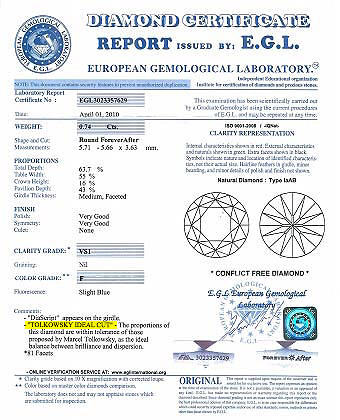
EGL Graded "Tolkowsky Cut Diamond" report.
The EGL diamond grading report on the left indicates that this diamond is Tolkowsky Cut. The comments section of the lab report reads as follows:
"TOLKOWSKY IDEAL CUT” (highlighted in yellow on the left)"the proportions of this diamond are within tolerance of those proposed by Marcel Tolkowsky as the ideal balance between brilliance and dispersion.”
According to the report issued by the European Gemological Laboratory (EGL) the diamond weighs 0.74 carats. The diamond measures 5.71 – 5.66 x 3.63 mm and has a total depth of 63.7% with a 55% a table diameter.
As you can see, the diamond has a crown height of 16% which is offset by a 43% pavilion depth. It's basically so deep that it probably looks similar to the tip of a standard #2 pencil. With this in mind, I fail to see how a diamond with these proportions qualifies as Tolkowsky cut. But wait, it gets even better...
Facet Structure of Tolkowsky's Diamond Design:
According to the EGL the Tolkowsky cut diamond above features an 81 facet design. As a matter of fact, the plotting diagram shows a modified round brilliant facet structure. Consequently, I find this shocking because Tolkowsky's Diamond Design shows the standard 58 facets.
In like manner, Tolkowsky's Diamond Design calls for a crown angle of 34.5 degrees. Which is offset by a pavilion angle of 40.75 degrees. At the same time, the design specifies a total depth of 59.3% with a 53% table diameter. It doesn't take a rocket scientist to see that the grading standards are world's apart given these differences.
As a matter of fact, I think that they're so far apart that if the parallel universe within which the EGL resides were to explode, that the etherial spirit of Marcel Tolkowsky wouldn't be able to recognize his theory at work through the wormhole of their existence.
Are Tolkowsky Diamonds The Best?
In the final analysis, it seems apparent that there are many different interpretations of Tolkowsky cut diamond available. With that in mind, I think it's prudent to look beyond the name and consider each diamond individually.
To begin with, Marcel Tolkowsky's calculations did not account for the girdle edge of a diamond. Which means that you're not likely to find a modern round brilliant with those proportions. As a matter of fact, it's technically impossible for a modern round to have a 0.00% girdle edge.
At the same time, the marvels of modern technology enable cutters like Brian Gavin to surpass anything that their predecessors dreamed possible.
With that in mind, I recommend something like the Black by Brian Gavin Diamond to the left. As you can see, that puppy's got it going on all the way around.
Gabriele Tolkowsky Facets The Famous Golden Jubilee Diamond:
If there's one thing I've learned during my 30+ years in the business, it's that diamond cutting is a family affair. For example, my good friend, Brian Gavin is a fifth-generation diamond cutter.
In similar fashion, world renowned diamond cutter Gabriele Tolkowsky, is Marcel's nephew. "Gabi" Tolkowsky is best known for cutting the famous 545.65 carats, Golden Jubilee Diamond.
The 148 facet cushion cut diamond on the left is a gorgeous fancy golden brown color. As a matter of fact, the name is in honor of the King of Thailand's celebrating his 50th year on the throne.
Consequently, the rough for the Golden Jubilee Diamond was found in the Premier Mine and weighed 755.50 carats!
The Premier Mine Yields Big Diamonds:
The Premier Mine is also where other biggies like the Cullinan, Taylor-Burton, and Centenary diamonds were discovered. Not surprisingly, the Golden Jubilee Diamond has an estimated value of $12 million.
Be that as it may, Jean Paul Tolkowsky, picked up the family torch in 2009. His lineage makes him a seventh generation diamond cutter which is something I taunt Brian Gavin with. Hey, what are friends for?
Sadly, Jean-Paul filed for Chapter 11 Bankruptcy protection for his company Exelco in 2017. Please understand that I'm stating a fact and not singling him out. As you might imagine, I have great respect for the Tolkowsky legacy.
In the first place, there might not be an ideal cut diamond without his contributions. The demise of this particular piece of the Tolkowsky Diamond Legacy coincides with the financial collapse of 2008.
AGS Ideal vs. EGL Tolkowsky Range:
Throughout the years, I've even seen the EGL describe fancy shape diamonds as Tolkowsky Cut. In the first place, Tolkowsky's Diamond Design is for a round brilliant cut diamond. With that in mind, it's simply not possible for a marquise, princess, or any shape other than round to be Tolkowsky cut.

Big Bird from Sesame Street.
In addition, I've seen "Tolkowsky Cut diamonds" score as low as AGS-2 Very Good for proportions using Sarin analysis. By all means, feel free to ask what gives with that?
Under those circumstances, it seems that damn near anything qualifies for the EGL "Tolkowsky Cut" rating.
In similar fashion, I suppose that the American Kennel Club (AKC) might classify my German shepherd as a Chihuahua. After all, they're both dogs of one sort or another.
At the same time, you might ponder my use of the word "DOG" as it applies to this particular situation. Suffice to say that Big Bird might suggest that "one of these things is not like the other."
Editorial Commentary from The Dog:

Duscha the Dog Weighs in on Tolkowsky Cut.
By the way, my German shepherd "Duscha" (doo-shah) is extremely upset about the Chihuahua analogy. First of all, he would like you to know that a Chihuahua is more like a rat than a dog.
(Forgive him, but one did try to gnaw through his stomach).
Secondly, GSD's are practically the only type of dog, as is proven by the name German Shepherd dog. Other types of canines are hounds, retrievers, shepherds, and terriers, but calling them dogs is a rather broad generalization.
In addition, any four-legged creature which "yips" rather than BARKS is probably just a cat or something. Don't get me wrong, I like cats, but they're not dogs.
Furthermore, anything with the words wa-wa, doodle, or pom in the name can't possibly be a dog. Why? Because dogs have to have strong, powerful names that command authority. For example, Duscha means Ghost or Spirit in Russian.
(Yea buddy, but it also means shower down here in Mexico. Plus, people think you're a girl because of the ha sound on the end).
Obviously, we're having a bit of fun.
The idea is to illustrate how different things can be despite their similarities. In like manner, calling a diamond "Tolkowsky Cut" does not necessarily make it so. In other words, you can call a Chihuahua a dog, but doing so does not make it a German Shepherd. With that in mind, it seems wrong to describe a diamond as Tolkowsky Cut unless the proportions meet his specifications.
Given these points, there is one last thing we should probably say: The views, opinions, positions expressed by the dog and those providing comments below are theirs alone. They do not necessarily reflect the views, opinions, or positions of the human or this website. If you're offended by this in any way, you might try adopting a dog (they're good therapy providers).
Read the writing on the wall above and leave a comment below.


